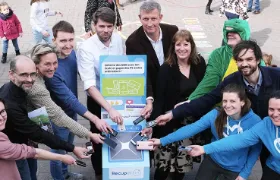How building a net zero and circular enterprise starts with procurement
Do you turn off the lights when you leave a room? If you do: good work, the environment and your wallet will thank you. But what if you told your friends to do the same? And they told their friends, and so on? Setting a good example can be a catalyst for change, and in my job at procurement, that’s something I think about every day. What can we change at procurement level to help build a net zero and circular enterprise? The answer: it’s about getting everyone aboard.
Karl Cuveele
Group Procurement Department Lead
My LinkedIn
In 2021, Proximus joined the European Green Deal Coalition, pledging to reach net-zero emissions by 2040. Additionally, we aim to become a truly circular company, achieve zero waste, and use 100% renewable energy by 2030. To succeed in our goal, it’s not just about us. It’s imperative that we engage our suppliers to reduce their CO2 footprint and make the shift towards circularity.
If we want large-scale impact, it’s up to companies like us to set new standards. And being able to contribute to that impact in my function as Group Procurement Department Lead at Proximus is something that motivates me every day. After all, with a buying power of about 2,5 billion each year, we’re one of the biggest players in Belgium – and we’re buying everything from mobile and fixed networks and devices to cars, buildings and energy to consultancy and contact center services. So, how do we get everyone aboard?
Screening suppliers
We took our first steps back in 2012, when we joined the JAC – a global telecom operator initiative – to jointly audit common suppliers and their tiers for human rights, social, labour and environmental standards. Together, we screened more than 1,250 suppliers across the globe so far, and that number continues to rise. We aim to have 75% of our suppliers with a positive CSR rating (assessments and audits) by 2025.
Even though the initiative started with a CSR focus, we shifted our attention more and more towards sustainability, so we can ensure a sustainable supply chain to meet our own public commitments.
Sourcing for sustainability
The sustainability component counts for 20% with the tenders we issue and will become even more important with new legislation coming in the near future. Choosing the right sustainable and circular product has become part of our daily duties together with our internal business partners. This way we want to make sure to shift towards our sustainable targets.
Collecting declarations of intent
Another example is our Manifesto, which we started about two years ago. It’s a declaration of intent we ask our suppliers to sign: what initiatives are they going to take to become more sustainable? Some of our bigger suppliers – for example tech companies like Cisco and Nokia – are already ahead of us in this regard. With local partners, it’s often still in an early stage, so that’s where we can really encourage change. So far, nearly 80 key suppliers have signed our manifesto, representing more than 50% of our supplier carbon footprint.
Determining real engagement
The next step for us is a Supplier Engagement Program. Here, we go from a declaration of intent to real engagement. How will our suppliers solidify those circular manifestos into concrete actions? What are the KPI’s and targets? It’s a real working partnership where we work together with our suppliers to determine: what are we going to do, by when, and how?
We’re already seeing great results from our initiatives. For our new Wi-Fi 6 Internet Boxes, we collaborated in-depth with our suppliers on various aspects: from the product design to the packaging. The devices themselves are made from recycled materials, are easy to reuse, refurbish or recycle and use minimal packaging and raw materials. On top of that, they’re equipped with more efficient technology, with an energy consumption that’s about 24% lower than that of the previous generation.
With an ever-growing number of suppliers hopping aboard our sustainability ship, I’m excited about our next endeavour. One thing is for certain: there is still plenty of uncharted territory to explore. We just need to keep looking forward.
Interested in this topic?


